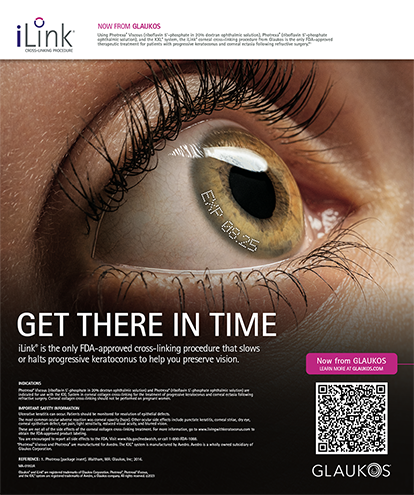INTRODUCTION
David F. Chang, MD: Most if not all of us have counseled cataract patients who express interest in knowing what IOL we would choose for our own eyes if we required cataract surgery. With so many different IOL choices today, this conversation seems more relevant now than ever before. Let’s get started.
Arthur B. Cummings, MB ChB, FCS(SA), MMed(Ophth), FRCS(Edin): Our panel includes a good mix of individuals who have already had cataract surgery and those who are approaching an age at which cataract surgery soon may be required. We’ll delve into IOL selection and find out just what lenses are top of mind for some of our colleagues.
PERSONAL PREFERENCES
Dr. Cummings: Dr. Packard, I don’t believe you’ve had cataract surgery yet. When the time comes, what IOL do you think you’ll choose?
Richard Packard, MD, DO, FRCS, FRCOphth: I’ll be 75 this year. I’m in a slightly strange position because the visual acuity in my right eye is 20/100 due to long-term sequelae from a central serous retinopathy that I had in my 40s. As a sidenote, I discovered in 2016 that vision in my right eye had declined when I covered my left eye by chance. I find it fascinating that my dominance moved from my right eye to my left without my realizing it had. About 35 years ago, after a short trial, I stopped wearing contact lenses. Long story short, I found I was uncomfortable without glasses on, especially outdoors with the breeze hitting my eyes. So, from my point of view, I would plan to continue wearing multifocal glasses after cataract surgery.
My current prescription is -8.00 D OS and -10.00 D OD. I would want to reduce that significantly, to about -2.50 D, which would improve my distance vision and leave me with some good unaided reading vision in my good left eye.
When the time comes for me to have cataract surgery and if my eyes both have good visual potential, I will likely choose an extended depth of focus (EDOF) IOL because it offers an attractive compromise in terms of avoiding the dysphotopsias that are commonly associated with diffractive IOLs. I like that EDOF IOLs provide a good range of vision. I would probably want a monovision approach with my dominant eye targeted for distance and intermediate vision and a little bit of myopia in my nondominant eye to provide me with near vision.
Dr. Chang: Dr. Packard, which EDOF design would you choose?
Dr. Packard: I’d probably go with the AcrySof IQ Vivity (Alcon), but the Tecnis Eyhance (Johnson & Johnson Vision) is another approach.
Dr. Chang: Dr. Koch, you’ve had cataract surgery already. What was your experience like, and what IOL did you choose?
Douglas D. Koch, MD: I had Eyhance lenses implanted in my eyes. I have glaucoma with some nerve fiber layer loss, and I had prior bilateral filtering surgery with Xen stents (Allergan) placed. I wanted to stay with a monofocal IOL because my central field of vision is superb, but to Richard’s point, I really like the concept of an EDOF IOL with minimal visual disturbances. The intended correction was -1.25 D. Had I not had glaucoma issues, I probably would’ve started with a Tecnis Symfony (Johnson & Johnson Vision) in my nondominant eye.
For my post-LASIK patients, I like the Tecnis Symfony because it has the best modulation transfer function based on data I have seen presented, and it has a nice flat landing zone for distance. Another lens I like in complicated eyes is the Light Adjustable Lens (RxSight), which, with the ActiveFocus design, is a great option that is well tolerated by patients. For patients who want crisp vision at all distances, I start with the nondominant eye and implant the Tecnis Synergy (Johnson & Johnson Vision) or AcrySof IQ PanOptix (Alcon) IOL. I then let patients decide what they want to do for the dominant eye, whether that be a monofocal IOL or an EDOF IOL to supplement with less glare.
Dr. Cummings: How long do you wait between eyes?
Dr. Koch: I typically give patients at least 2 to 3 weeks.
Dr. Cummings: Dr. Masket, you’ve also had cataract surgery already. Tell us about your experience and your lens selection.
Samuel Masket, MD: I’m 78 years old. I voluntarily stopped performing surgery at age 75, and therefore I have no personal experience implanting most of the IOLs we’re talking about. I have, however, performed cataract surgery on many ophthalmologists over the years, and none chose a diffractive IOL. I put them in their loved ones, but they never wanted diffractive optics themselves.
I think one thing all of us can agree upon is that no IOL is perfect. You must choose what may be best for you based upon things like lens material and profile, visual side effects, and dysphotopsias.
Richard P. Kratz, MD, performed my cataract surgery about 40 years ago. At that time, obviously, there was but one option. Dr. Kratz implanted a rigid 6-mm IOL made of PMMA with four fixation holes and modified J-loop polypropylene haptics that were placed in the ciliary sulcus. The plan was to give me emmetropia, but because applanation ultrasound was used in those days, I wound up myopic. Over the course of my career, I’ve been about -1.50 to -1.75 D bilaterally. It works fabulously for office work and surgery. I have a wonderful quality of vision, and I’ve enjoyed being myopic. Socially I wear one contact lens for monovision and two for athletics. When wearing both contact lenses, I am horribly presbyopic and very intolerant of it.
If I required cataract surgery in the present day, my choice would be between the Eyhance and the Light Adjustable Lens. I might gravitate toward the adjustable lens because I would like the ability to fine-tune the outcome. This, of course, is if I were a good candidate for silicone IOLs.
Dr. Chang: Dr. Schallhorn, what would you choose for yourself?
Steven C. Schallhorn, MD: I have two considerations for the choice of an IOL. First, high quality and clarity of vision are more important to me than spectacle independence. Second, I have early signs of macular degeneration with a strong family history. Putting this together, I would choose a monofocal lens. Monofocal IOLs in today’s market are very good, and my top choice would be the aspheric CT Lucia (Carl Zeiss Meditec), which has a hydrophobic C-loop design and best-in-class optics.
Dr. Cummings: Professor Tassignon, what about you?
Marie-Jose Tassignon, MD, PhD, FEBO: I have natural monovision; I am emmetropic in one eye and -1.75 D in the other. I would prefer a lens that the surgeon can center based on my visual axis, does not change position due to posterior capsular opacification, does not induce dysphotopsias, and can be replaced easily. I would also prefer a hydrophilic IOL because it is the most biocompatible in the eye. For me, the Bag-in-the-Lens (Morcher) would be my top choice. We are currently designing a model that can provide continuous extended depth of focus. At this time, however, I would choose a monofocal lens, even though it transmits more light than the natural crystalline lens.
Dr. Chang: What amount of myopia in your near eye would you want?
Professor Tassignon: I am -1.75 D OD and plano OS. I would like to keep that.
Dr. Cummings: Dr. Spalton, what IOL you would select for yourself?
David J. Spalton, FRCS, FRCP, FRCOphth: I’m starting to get some nuclear lens opacity, and I have a little glare at night, so I’m thinking about this topic fairly seriously. Above all else, I want to have clear, sharp vision. I like to fish, and I want to see the fly on the water. I’ve been wearing spectacles since I was 6 years old, and it doesn’t bother me. I want good distance vision, but I’m a myope. I also like taking off my spectacles, and I’ve gotten used to that to see things near to me. Knowing all of this, I would want to target -2.75 D in each eye. I have about 1.50 D astigmatism, so I would also want a toric lens.
Regarding lens material, I prefer a hydrophobic glistening-free lens such as the Tecnis (Johnson & Johnson Vision) or the enVista (Bausch + Lomb). Another important consideration is the surgeon. I would prefer to choose my surgeon first and then choose a lens that they are familiar with.
If I were 85 years old, I would think rather differently. At that age, I’d probably be leading a less active lifestyle and prefer the Symfony IOL bilaterally. Right now, however, the nearest thing to certainty is to have a monofocal lens without dysphotopsias and glare.
Dr. Chang: Dr. Cummings, what would you choose as a patient who has a history of refractive surgery?
Dr. Cummings: I had topography-guided LASIK 11 years ago with the Contoura (Alcon), and I targeted 0.00 D OD and -1.50 D OS. My corneas are pristine, so I can choose any lens I want. Further, I’ve become completely used to blended vision. If there was one thing I’d like to enhance, it would be better stereoscopic vision at near. I think my best chance of achieving that is with the Vivity IOL. I’m comfortable using the Vivity in postrefractive surgery eyes; I can offset the eyes by as little as 0.50 or 0.75 D and still get a full range of vision, so I think that’s what I would do for myself.
Dr. Chang, you’re the youngest on the panel. What would you do?
Dr. Chang: I’m currently -0.75 D OD and -1.00 D OS. I would pick the Light Adjustable Lens and titrate the outcome to as little myopia in my left eye as possible to still see mobile devices and a computer. I’d go for distance in my right eye, but I’d be curious to test whether -0.50 D OD would be preferable to plano. I am partial to silicone material because it’s the closest of the lens materials to the index of refraction of the crystalline lens, and it seems to have the least potential for positive dysphotopsia.
TREATING LOVED ONES
Dr. Cummings: There is no denying that we are all particular about our vision. Due to the nature of our profession, we want to see well, and we want to see close. What would everyone do for their partners if they wanted visual freedom from glasses?
Personally, I’d select a trifocal IOL for my wife. She’s had LASIK, and I think a trifocal would work for anybody who adjusted well to blended vision before.
Dr. Packard: My wife was an ophthalmologist. She probably would think the same way that we do. I suspect she’d like to not wear glasses if she could still have a reasonable quality of vision, and I think EDOF lenses with a bit of monovision would be the best choice for her.
Dr. Spalton: My wife is a low hyperope. We spend hours a day looking for her reading glasses. I would welcome the opportunity for her to have a Symfony in both eyes. It would certainly simplify life in the household.
Professor Tassignon: All of my loved ones who have had cataract surgery received the Bag-in-the-Lens. This is my one-size-fits-all IOL.
Dr. Koch: I would demonstrate monovision contact lenses to see if that strategy was acceptable because you can always correct that if it doesn’t seem to be working. Then, we’d talk about glare and vision quality and choose between a trifocal and an EDOF IOL.
Dr. Schallhorn: My wife had monovision LASIK years ago and has been very happy with it. This makes the choice easy: I would select monovision with monofocal IOLs for her.
Dr. Masket: I did my wife’s first eye in 2004. In those days, we had only about four IOL formulas. I ran each of them, and all gave me a difference of 0.50 D. She was an axial hyperope, and toric IOLs weren’t available at that time. I therefore did a limbal relaxing incision to treat the astigmatism at the time of cataract surgery, and she wound up about -0.25 D with a small amount of residual cylinder. About a year later, when my wife was ready for cataract surgery on her second eye, toric IOLs were available in the United States, and she wound up emmetropic in that eye. She dislikes the first eye in comparison to the second eye and never lets me forget it!
Dr. Chang: I want to thank everybody for being so candid. It was insightful to hear all of the different preferences we have among us as colleagues.












